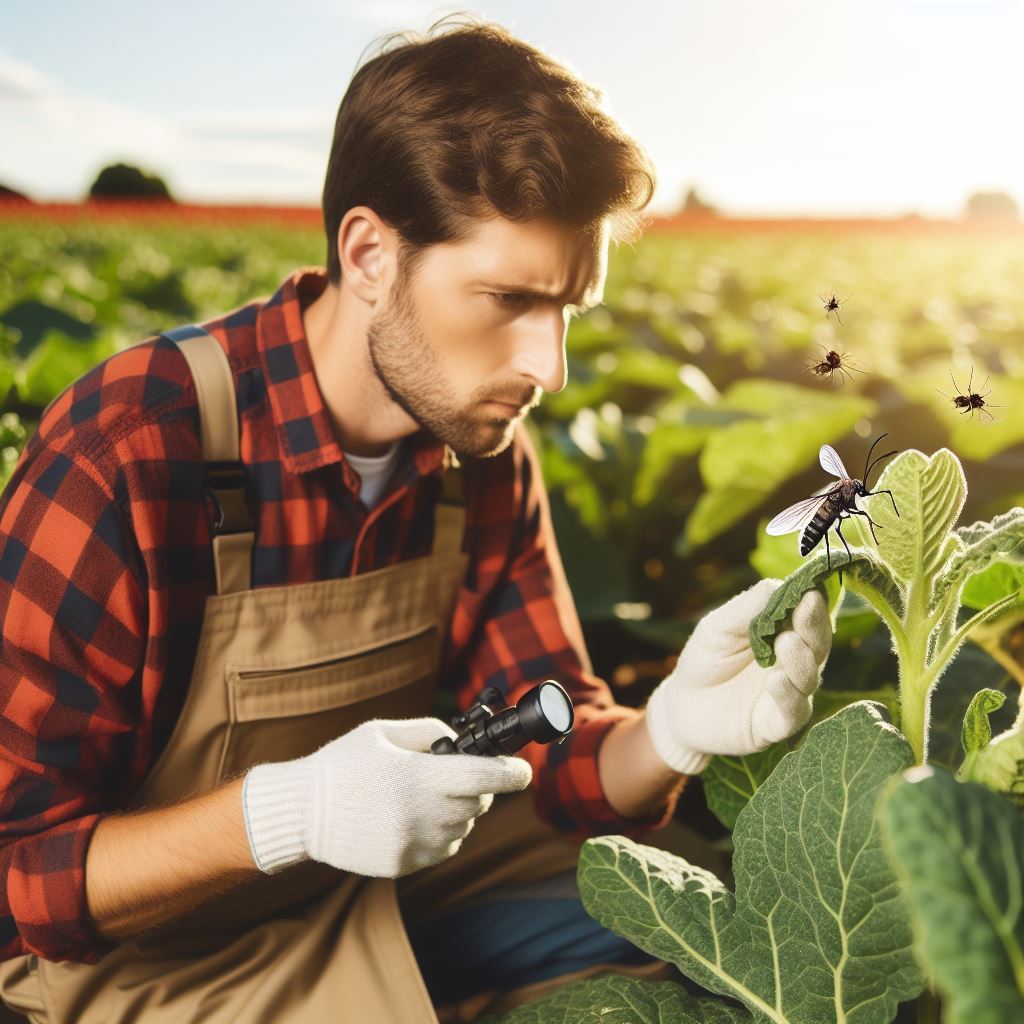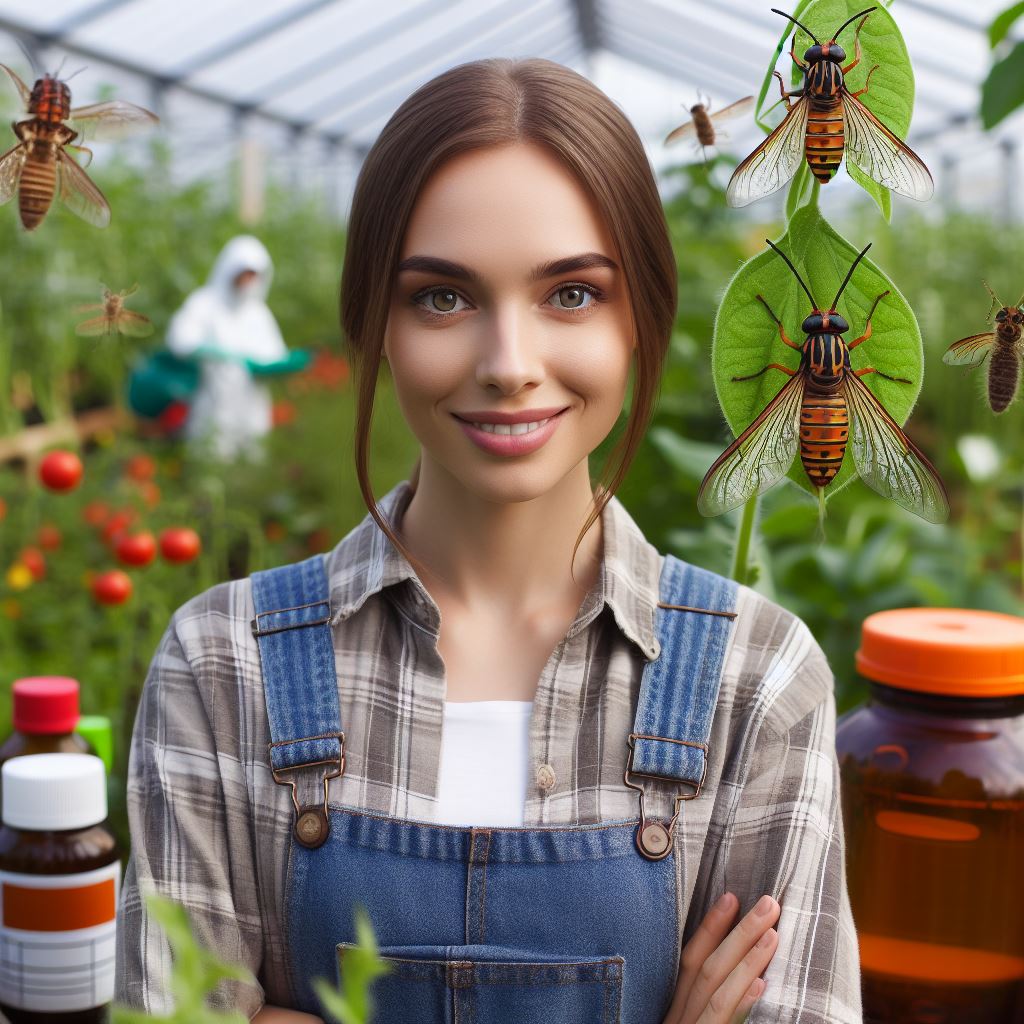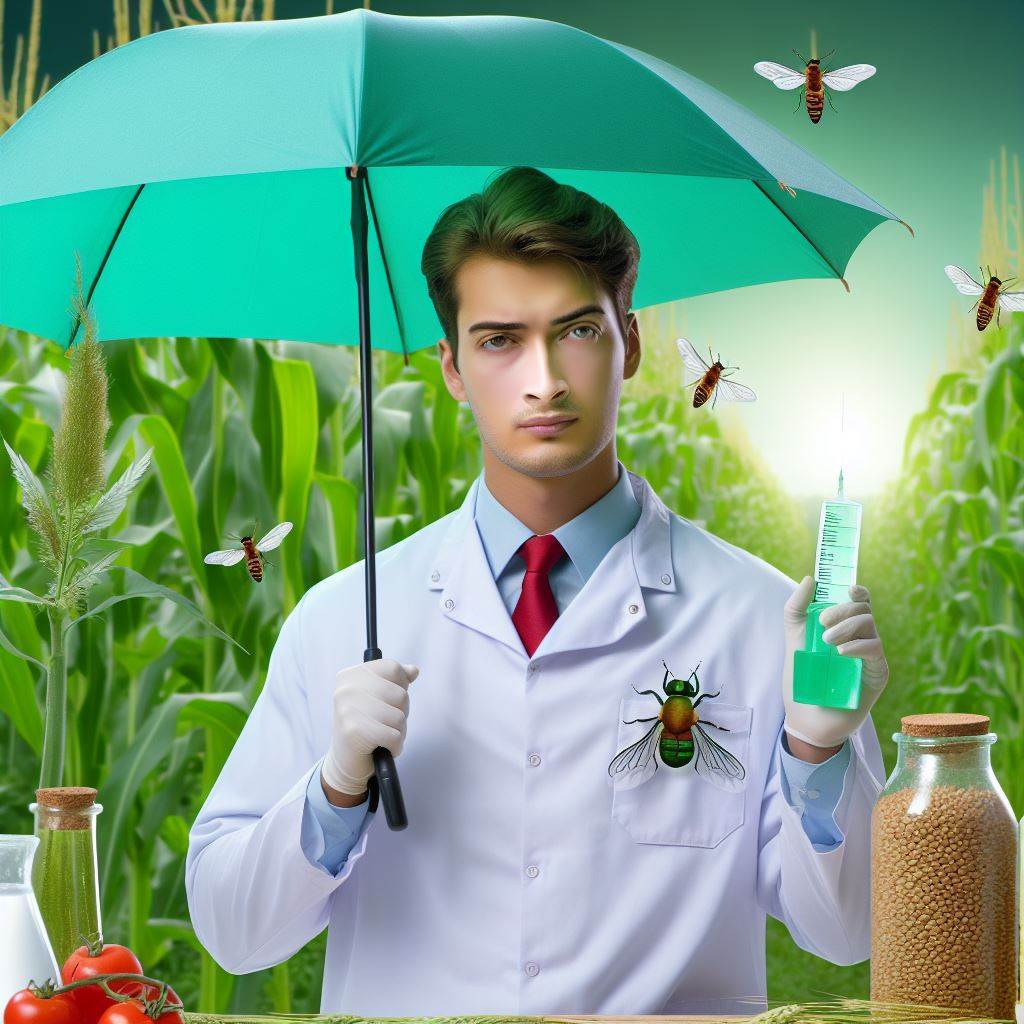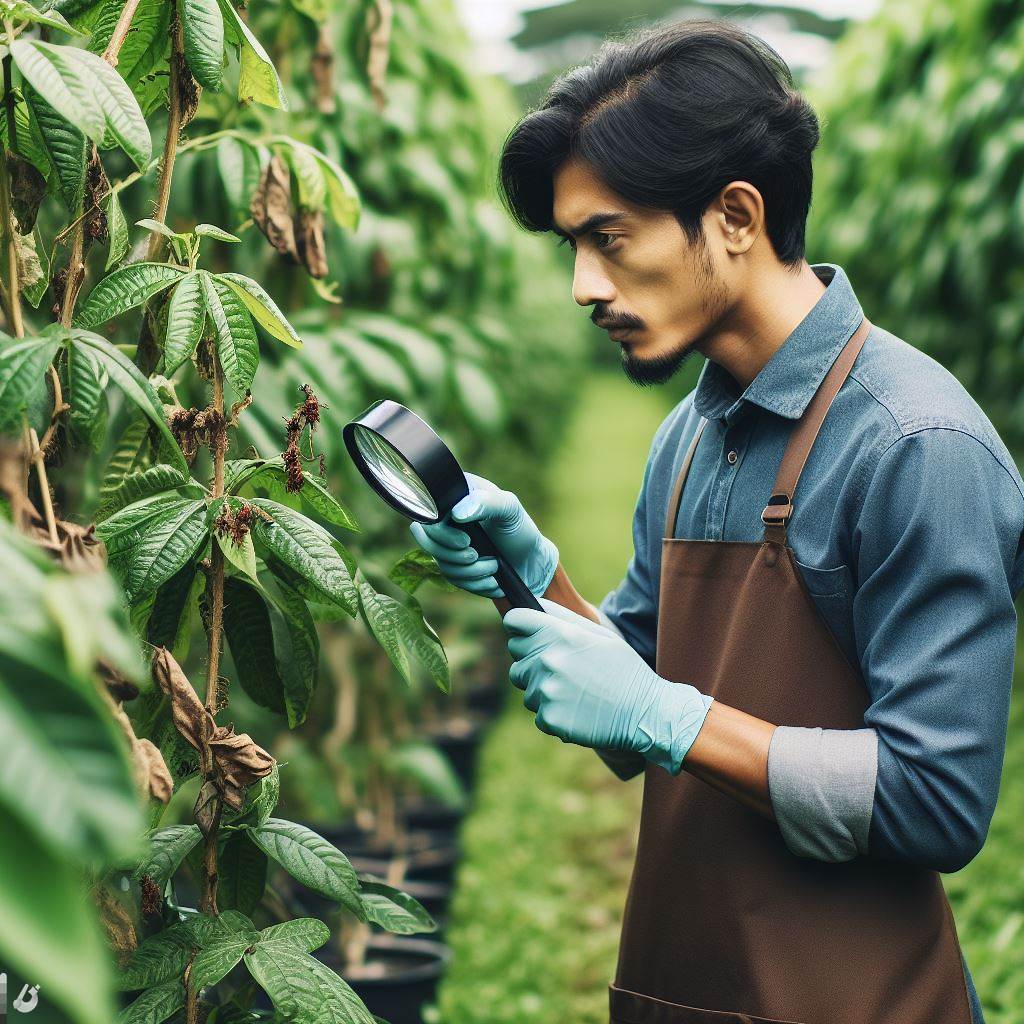Introduction
In sustainable farming, practices are implemented that prioritize the long-term health of ecosystems while ensuring food security and economic stability for farmers.
This approach acknowledges the interconnectedness of environmental, social, and economic aspects of farming.
Integrated Pest Management (IPM) is an essential component of sustainable farming. IPM focuses on minimizing the impact of pests by using a combination of preventive measures, monitoring techniques, and control strategies.
This approach aims to reduce reliance on chemical pesticides and encourages the use of natural methods.
IPM involves various strategies, including cultural practices, biological control, and the targeted use of pesticides when necessary.
It takes into account the specific needs and challenges of each farm, considering factors such as climate, crop type, and pest populations.
By adopting IPM, farmers can effectively manage pests while minimizing environmental harm and reducing costs.
This approach promotes a healthier ecosystem by preserving natural enemies of pests and enhancing biodiversity.
It also prioritizes the safety of consumers by minimizing pesticide residues in agricultural products.
Overall, understanding IPM and its principles is essential for sustainable farming practices.
By implementing IPM strategies, farmers can achieve long-term pest control while minimizing negative impacts on the environment and human health.
What is IPM?
Definition and concept of IPM
Integrated Pest Management (IPM) is a holistic approach to pest control that emphasizes prevention and minimization of chemical interventions.
It involves integrating various pest management techniques, including biological control, habitat manipulation, and cultural practices.
Main objectives and principles of IPM
- Reduce chemical pesticide use: IPM aims to minimize reliance on synthetic pesticides, reducing their impact on human health and the environment.
- Economic feasibility: IPM seeks to ensure cost-effective pest management strategies that are economically viable for farmers.
- Preserve ecosystem balance: IPM considers the long-term impacts of pest control on biodiversity and aims to maintain ecological equilibrium on the farm.
- Enhance crop productivity: By managing pests effectively, IPM helps optimize crop yields and ensures high-quality produce.
- Sustainable farming practices: IPM promotes a resilient and regenerative farming system that balances productivity and environmental stewardship.
- Scientific approach: IPM relies on scientific research and evidence-based practices to effectively manage pests.
- Prevention and monitoring: IPM emphasizes proactive measures, such as regular monitoring, to identify pest populations and prevent outbreaks.
- Multiple intervention options: IPM integrates a range of pest control strategies to create a diverse and adaptive management system.
- Farmer education and empowerment: IPM encourages farmers to be actively involved in decision-making and equips them with the knowledge and tools to implement IPM practices.
- Continuous improvement: IPM advocates for the continuous evaluation and refinement of pest management strategies to adapt to changing conditions.
Implementing IPM requires a thorough understanding of the pest biology, knowledge of management methods, and regular monitoring.
By employing IPM, farmers can reduce pesticide use, protect beneficial insects, and promote environmental sustainability.
Transform Your Agribusiness
Unlock your farm's potential with expert advice tailored to your needs. Get actionable steps that drive real results.
Get StartedThis approach not only benefits the farmers economically but also contributes to a healthier ecosystem and safer food production.
IPM is an essential tool in sustainable farming as it helps strike a balance between pest control and environmental preservation.
Adopting IPM practices can contribute to the long-term viability of agricultural systems while safeguarding human health and the planet.
Read: Organic IPM Solutions for Healthy Crops
Components of IPM
Integrated Pest Management (IPM) is a sustainable farming approach that aims to manage pests effectively while minimizing reliance on chemicals.
By understanding the components of IPM, farmers can promote the health of their crops and reduce environmental impacts.
Prevention and avoidance
Prevention and avoidance are key elements of IPM. Cultural practices, such as crop rotation, can disrupt pest life cycles and reduce their populations.
Additionally, diversifying crops can decrease pest susceptibility and enhance biodiversity on the farm.
Monitoring and identification
Monitoring and identification play a crucial role in IPM. Regular field inspections enable farmers to detect pest populations early on.
By identifying both pests and beneficial insects, farmers can make informed decisions about pest management strategies.
Threshold determination
Threshold determination involves establishing action thresholds for pest control.
Through monitoring and analysis, farmers can determine the pest population levels at which intervention becomes necessary. This helps prevent unnecessary pesticide use.
Control measures
Control measures in IPM focus on employing environmentally-friendly methods.
Biological control methods, such as introducing natural predators, can effectively suppress pest populations.
Pheromones and traps can also be used to disrupt pest mating and monitor their activity.
Selective pesticides are only used as a last resort when all other options have been exhausted.
Implementing IPM requires an integrated and proactive approach.
Farmers need to consistently implement prevention and avoidance practices, conduct regular monitoring and identification activities, and establish clear threshold levels.
By doing so, they can determine the appropriate timing and methods for intervention.
One of the key benefits of IPM is its ability to minimize pesticide use.
This not only reduces the potential harm to human health and the environment but also mitigates the development of pesticide resistance in pests.
IPM supports sustainable farming practices that prioritize ecological balance and long-term productivity.
Overall, understanding the components of IPM empowers farmers to adopt a holistic pest management approach.
By combining prevention, monitoring, threshold determination, and control measures, farmers can effectively manage pests in a sustainable manner.
Showcase Your Farming Business
Publish your professional farming services profile on our blog for a one-time fee of $200 and reach a dedicated audience of farmers and agribusiness owners.
Publish Your ProfileEmbracing IPM principles promotes ecosystem health, biodiversity, and the long-term viability of farming systems.
Read: IPM: Balancing Nature & Agriculture Sustainably
Benefits of IPM in Sustainable Farming
A sustainable farming system incorporates various practices to protect crops from pests while minimizing the impact on the environment.
Integrated Pest Management (IPM) is one such approach that offers several benefits.
In this section, we will explore the advantages of implementing IPM strategies in sustainable farming.
Reduction in Pesticide Usage
One significant benefit of IPM in sustainable farming is the reduction in pesticide usage.
Unlike conventional farming methods that rely heavily on pesticides, IPM emphasizes the use of alternative pest management techniques.
By employing biological controls, crop rotation, and habitat manipulation, farmers can reduce their reliance on harmful chemicals, thus minimizing pesticide residues in the environment.
- Biological Controls: IPM encourages the introduction of natural enemies, such as beneficial insects, to control pest populations. These predators and parasites act as a sustainable solution to pest management.
- Crop Rotation: By rotating crops, farmers disrupt the life cycle of pests, making it harder for them to survive and reproduce. This reduces the need for pesticide applications.
- Habitat Manipulation: Creating diverse habitats around agricultural fields promotes natural biodiversity, attracting beneficial insects that prey on pests. This natural balance helps reduce the reliance on chemical interventions.
Preservation of Beneficial Insects and Biodiversity
IPM in sustainable farming focuses on preserving beneficial insects and promoting biodiversity.
Beneficial insects play a crucial role in natural pest control, and their presence can significantly reduce the need for pesticide treatments.
- Ladybugs, lacewings, and parasitic wasps are examples of beneficial insects that feed on harmful pests, acting as natural predators.
- Implementing IPM practices allows these beneficial insects to thrive, maintaining a balanced ecosystem that supports long-term pest management.
Moreover, promoting biodiversity through IPM strategies helps sustain the overall ecosystem.
By creating a diverse habitat, farmers support various plant and animal species, contributing to environmental conservation.
Cost-effectiveness
IPM in sustainable farming offers long-term cost-effectiveness.
While the initial adoption of IPM practices may require additional investments and efforts, it leads to reduced expenses in the long run.
- By relying less on expensive pesticides, farmers can save money on chemical purchases.
- IPM strategies that focus on prevention and early intervention help farmers avoid costly damage caused by severe pest infestations.
- Additionally, IPM can improve crop quality and yield, resulting in higher profits for farmers.
Minimization of Environmental Impact
One of the primary goals of sustainable farming is to minimize environmental impact, and IPM aligns perfectly with this objective.
- Reducing pesticide usage through IPM practices lowers the risk of chemical contamination in soil, water, and air.
- IPM also prevents the development of pesticide-resistant pests by utilizing diverse pest management tactics.
- The preservation of natural habitats through IPM contributes to overall environmental conservation and promotes ecological sustainability.
In fact, implementing IPM strategies in sustainable farming provides numerous benefits.
It reduces pesticide usage, preserves beneficial insects and biodiversity, offers cost-effectiveness, and minimizes environmental impact.
By adopting IPM, farmers can achieve sustainable pest management while safeguarding the environment for future generations.
Read: Eco-Friendly IPM Techniques in Modern Farms

Challenges and Limitations of IPM
Lack of awareness and training
- Farmers may not be aware of the benefits of IPM or how to implement it properly.
- Insufficient training programs can result in ineffective implementation of IPM strategies.
- Education and awareness campaigns are needed to spread knowledge about IPM among farmers.
Initial costs and implementation challenges
- Adopting IPM strategies may require an initial investment for equipment, pesticides, and monitoring tools.
- Some farmers may face financial limitations and find it challenging to bear the costs.
- Implementing IPM practices can also be time-consuming and labor-intensive, especially during the transition phase.
Unpredictable factors affecting pest populations
- Pest populations can be influenced by various factors, including climate change, invasive species, and pesticide resistance.
- This unpredictability makes it difficult to devise effective IPM strategies that consistently control pests.
- Ongoing research and monitoring are necessary to understand and adapt to changing pest dynamics.
Efforts made to overcome these obstacles
Despite the advantages of IPM, these challenges and limitations can hinder its widespread adoption and success.
However, efforts can be made to overcome these obstacles:
Increasing awareness and providing training
- Government agencies, agricultural organizations, and extension programs should conduct workshops and training sessions to educate farmers about IPM.
- Information on IPM techniques, benefits, and implementation strategies should be easily accessible through online resources, publications, and local workshops.
- Collaboration with universities and research institutions can provide expertise and training to farmers.
Financial assistance and incentives
- Government and non-governmental organizations should provide financial aid and incentives to farmers to help them adopt IPM practices.
- Subsidies for equipment, pesticides, and monitoring tools can reduce the initial costs and implementation challenges.
- Reward programs for farmers who successfully implement IPM and achieve sustainable pest management should be introduced to encourage wider adoption.
Integrated approaches and technological advancements
- Integrated approaches that combine different IPM strategies can enhance pest control effectiveness.
- Advancements in technology, such as pest monitoring sensors and drones, can facilitate early detection and targeted management of pests.
- Biocontrol methods, involving the use of natural enemies to control pests, should be promoted and supported through research and development.
In essence, while IPM offers a sustainable approach to pest management in farming, there are challenges and limitations that need to be addressed.
Lack of awareness and training, initial costs, and implementation challenges, as well as unpredictable factors affecting pest populations, can hinder the adoption of IPM.
However, through increased awareness, financial support, and technological advancements, these obstacles can be overcome, leading to the successful integration of IPM in sustainable farming practices.
Read: Soil Conservation: Tackling Erosion Smartly
IPM Success Stories and Case Studies
Implementing IPM strategies in agriculture has shown significant success in improving farm productivity and sustainability.
Farms that have adopted IPM practices have experienced positive outcomes, not only in terms of pest control but also in terms of crop yield and environmental impact.
This section highlights some examples of farms that have successfully implemented IPM strategies and their resulting achievements.
Examples of farms implementing successful IPM strategies
A prime example is the Smith Family Farm in Iowa. By utilizing IPM techniques such as the use of biological control agents, crop rotation, and trap crops, they have managed to effectively control pests while minimizing pesticide use.
As a result, the Smith Family Farm has reduced their pesticide use by an impressive 50%.
Additionally, they have observed a considerable decrease in pest damage and a simultaneous increase in crop yield.
Their success story has inspired neighboring farms to adopt IPM strategies, leading to a positive shift in the region’s farming practices.
Another notable success story is the Johnson Organic Farm in California. This farm has seen remarkable improvements in both yield and sustainability after implementing IPM practices.
Through crop diversification, the use of beneficial insects, and regular monitoring, they have achieved a 30% increase in yield.
By relying less on pesticides, they have also played a pivotal role in minimizing the harmful effects of these chemicals on the environment.
The Johnson Organic Farm serves as a prime example of how IPM can benefit not just the farmer but also the broader ecosystem.
Highlighting the positive impact on yield and sustainability
These success stories illustrate the positive impact of IPM on both farm productivity and sustainability.
By adopting IPM strategies, farmers can reduce their reliance on pesticides while effectively managing pests.
This not only helps to protect their crops but also leads to higher yields. Furthermore, by minimizing pesticide use, farmers contribute to the preservation of a healthy environment.
The examples of the Smith Family Farm and the Johnson Organic Farm demonstrate how IPM can be successfully implemented and highlight the multitude of benefits that can be reaped from this approach.
Showcase Your Farming Business
Publish your professional farming services profile on our blog for a one-time fee of $200 and reach a dedicated audience of farmers and agribusiness owners.
Publish Your ProfileIn a nutshell, IPM success stories and case studies underline the effectiveness of IPM strategies in sustainable farming.
Farms that have incorporated IPM practices have witnessed reduced pest damage, increased crop yield, and minimized pesticide use.
These outcomes support the notion that IPM is a viable solution for overcoming pest-related challenges while maintaining long-term sustainability in agriculture.
Conclusion
The importance of IPM in sustainable farming cannot be emphasized enough.
Integrated Pest Management (IPM) maximizes crop yields while minimizing environmental impact. It combines biological, cultural, and mechanical strategies.
IPM fosters biodiversity, reducing the reliance on chemical pesticides. This approach safeguards beneficial insects, essential for natural pest control.
Strategic monitoring and early pest detection are IPM cornerstones. Timely intervention prevents crop losses and avoids excessive chemical applications.
Crop rotation and cover cropping disrupt pest life cycles, promoting soil health. This sustainable farming method enhances resilience to climate change and fosters long-term agricultural viability.
Farmers, embrace IPM for sustainable, eco-friendly farming. Advocate for its adoption in your community, cultivating a resilient and prosperous agricultural future.
It is crucial for farmers to adopt and promote IPM practices for a more sustainable future.




